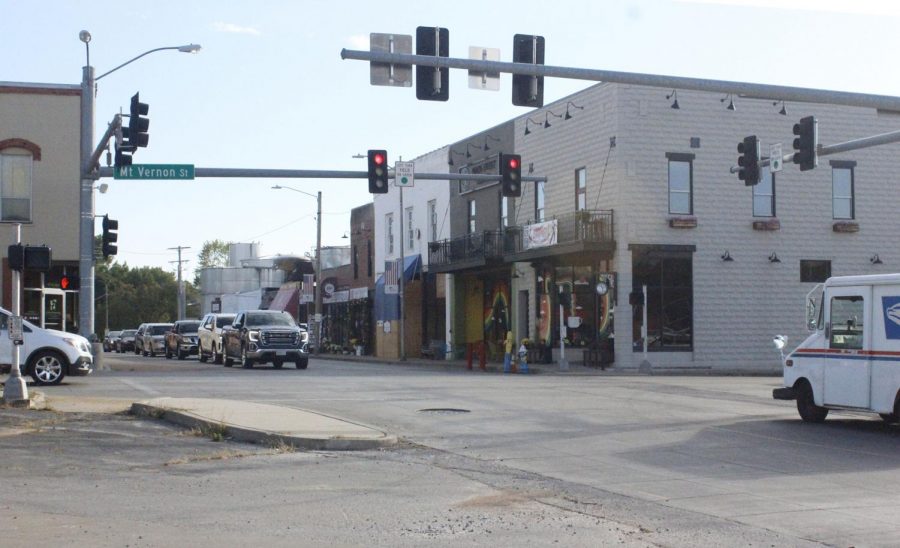Nixa from THEN to NOW
Nixa emerges from an overlooked crossroads to a thriving community.
Nixa’s Main Street is being expanded this year.
October 11, 2021
Nixa, the city that houses 21,544 people, wasn’t always the size it was now — it used to be a small crossroad site back in the 1800s. As time went on, this small crossroad site became bigger as the population increased.
In the 1800s, Nixa was a convenient spot to stop. Farmers and traders settled in Nixa, but the first citizens were Native Americans.
According to the book ‘Mid the Hills, a History of Nixa 1835-2001,’ by Wayne Glenn, in the 1850s, there was tension between slaveholders and the opposing party. Many people from Nixa in the 1850s were anti-slavery.
Some people around the U.S. that didn’t agree with slavery found a welcome place in Nixa. Many of them disagreed with family and others who were in favor of owning slaves.
There is no other city named Nixa.
“Nixa is the only one in the world simply because it was named this — no other community has chosen to follow the lead,” Glenn said.
When naming the town, people suggested that the word ‘nix’ best described the town, and then added an A in honor of the early leader, Nicholas A. Inman.
Business people in 1900 had plans for Nixa to compete against Ozark.
Within 20 years, Nixa had doubled its size and number of businesses.
Sucker Day is a key part of the history of Nixa. Sucker Day was started to promote business and events. According to ‘Tune in on Nixa in 1960 as Mayberry,’ by Wayne Glenn, many businesses closed for the first official Sucker Day.
“The first official Nixa Sucker Day celebration was held on Wednesday May 7, 1958, as proclaimed by Mayor Kirk Hawkins. 34 of 36 local businesses closed for the event,” TNM said.
Nixa schools weren’t always the vast spread of schools that people see now. It was like most places with just one elementary school, junior high and high school.
The high school moved around with expansion. According to ‘Mid the Hills, a History of Nixa 1835-2001.’
“A north school on North Main was added for 5th, 6th and 7th grades in 1966; later with many additions and much modernizing, this site became the high school in the early 1980s. In 2000, the high school moved southwest on Nicholas Road,” MHHN said.
Jim Middleton, the NHS driver’s education teacher, graduated from Nixa in 1979. Middleton’s senior class is much smaller than the classes of today.
“I graduated with 74 students total in the senior class, in ’79 it changed a little bit,” Middleton said.
This year’s senior class is 454 students, big.
The main spot in Nixa back in the 1970s was Main Street. Most, if not all, major buildings were there — such as banks and general stores.
“Main street was the big pub,” Middleton said. “[Nixa] Hardware was on main street at that time [and] we had two grocery stores and a couple of restaurants too. Everything really revolved right around Main Street.”
Back then, there were many different kinds of businesses, compared to today.
“There was a milk plant where farmers brought their cows’ milk to be made into cheese — it was the Wilson and Company factory,” Glenn said. “There were three or four gasoline stations, and there was a car dealership called M and W Chevy where cars and trucks were bought and sold.”
Nixa was mostly farmland in the beginning. The streets eventually widened throughout the years.
“The road to Springfield from here was a two-lane highway — 160 was all two lanes,” Middleton said. “At the intersection by Nixa Hardware, it was a four way stop. It shows just how much Nixa changed.”
In the 1980s housing grew largely because Branson was a popular destination and Springfield’s general health care system.
Many buildings in the 1980s were called different names than what they are called today.
“Housing arose — it started in the 1980s,” Middleton said. “It grew exponentially, Branson was a very popular destination and so was Springfield. [The] health care system [was] growing.”
Aaron Wells, an American government teacher at NHS, lived in Nixa almost his entire life. He recalls when Nixa was a small town.
“Everyone knew everyone. Neighbors talked to neighbors. It was more of a rural community,” Wells said.
Throughout the years, the number of Nixa residents continued to grow.
From 1880 through 1900 the population grew to 944 people. The population continued to grow between 1970 and 2000 to more than 12,124.
Nixa is what it is today due to the travelers that came for its success and the convenient location.
“People moved into the area because of the success of sports, educational processes, band and art too,” Wells said.
Traveling to Springfield to Nixa continues to be quick and convenient.
“Anything [that] came south out of Springfield … this is where they stopped,” Middleton said. “It was a one day journey from there down to here and so that’s how Nixa became the town it is today.”





